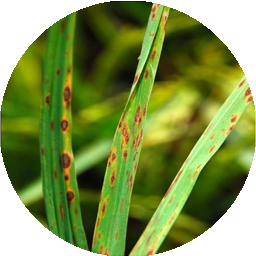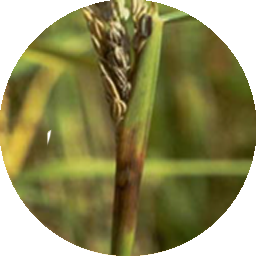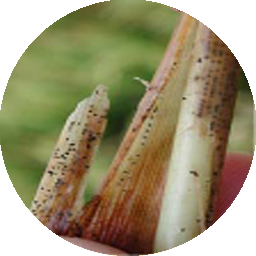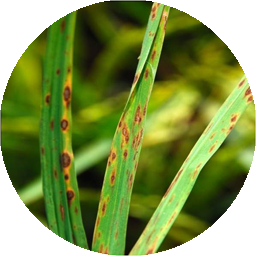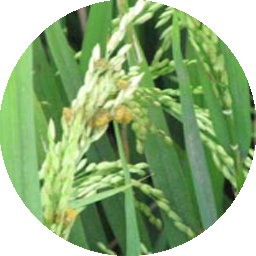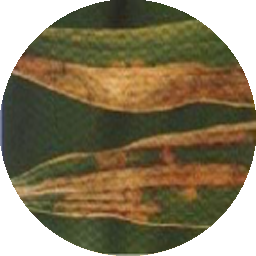Rice Symptoms & Management
×
Symptoms:
The fungus attacks the crop at all stages from seedlings in nursery to heading in main field. The typical symptoms appear on leaves, leaf sheath, rachis, nodes and even the glumes are also attacked.
Leaf blast:
On the leaves, the lesions start as small water soaked bluish green specks, soon enlarge and form characteristic spindle shaped spots with grey centre and dark brown margin. The spots join together as the disease progresses and large areas of the leaves dry up and wither. Similar spots are also formed on the sheath. Severely infected nursery and field show a burnt appearance.
Node blast:
In infected nodes, irregular black areas that encircle the nodes can be noticed. The affected nodes may break up and all the plant parts above the infected nodes may die (Node blast).
Neck blast:
At the flower emergence, the fungus attacks the peduncle which is engirdled, and the lesion turns to brownish-black. This stage of infection is commonly referred to as rotten neck/neck rot/neck blast/panicle blast. In early neck infection, grain filling does not occur and the panicle remains erect like a dead heart caused by a stem borer. In the late infection, partial grain filling occurs. Small brown to black spots also may be observed on glumes of the heavily infected panicles.
Management:
Use of seeds from a disease free crop
Grow resistant varieties like Simhapuri, Tikkana, Sriranga, Phalguna, Swarnadhan, Swarnamukhi, MTU 7414, MTU 9992, MTU 1005, Swathi, IR 64, IR 36, Sravani, Jaya, Vijaya, Ratna, RP 4-14, IET 1444, IR20, TKM 6, MTU-3 & 5 and NLR 9672 & 9674 in different tracts of Andhra Pradesh.
Remove and destroy the weed hosts in the field bunds and channels.
Split application of nitrogen and judicious application of nitrogenous fertilizers
Treat the seeds with Captan or Thiram or Carbendazim or Carboxin or Tricyclazole at 2 g/kg.
Seed treatment with biocontrol agent Trichoderma viride@ 4g/kg or Pseudomonas fluorescens @ 10g/kg of seed. Avoid close spacing of seedlings in the main field.
Spray the nursery with Carbendazim 25 g or Edifenphos 25 ml for 8 cent nursery.
Spray the main field with Edifenphos@0.1% or Carbendazim@0.1% or Tricyclazole @0.06% or Thiophanate Methyl@0.1%.
×
Symptoms:
The fungus attacks the crop from seedling in nursery to milk stage in main field. Symptoms appear as lesions (spots) on the coleoptile, leaf blade, leaf sheath, and glumes, being most prominent on the leaf blade and glumes. The disease appears first as minute brown dots, later becoming cylindrical or oval to circular. The several spots coalesce and the leaf dries up. The seedlings die and affected nurseries can often be recognized from a distance by their brownish scorched appearance. Dark brown or black spots also appear on glumes which contain large number of conidiophores and conidia of the fungus. It causes failure of seed germination, seedling mortality and reduces the grain quality and weight. The disease is associated with a physiological disorder known as akiochi in Japan. Abnormal soil conditions (Deficiency of potassium) predispose the plants to heavy infection.
Management:
Use disease free seeds.
Field sanitation-removal of collateral hosts and infected debris in the field.
Crop rotation,
Adjustment of planting time
Proper fertilization
Use of slow release nitrogenous fertilizers is advisable.
Good water management
Use of soil amendments
Grow disease tolerant varieties viz., Bala, BAM 10, IR-20, Jaya, Ratna, Tellahamsa and Kakatiya.
Treat the seeds with Thiram or Captan at 4 g/kg and with Mancozeb @0.3%
Spray the crop in the main field twice with Mancozeb@0.2%, once after flowering and second spray at milky stage.
×
Symptoms:
Sheath rot occurs usually at the booting stage of the crop. Initial symptoms are noticed only on the upper most leaf sheath enclosing young panicles. The flag leaf sheath show oblong or irregular greyish brown spots. They enlarge and develop grey centre and brownmargins covering major portions of the leaf sheath. The young panicles may remain within the sheath or emerge partially. The affected sheath and panicles rot and abundant whitish powdery fungal growth is formed inside the leaf sheat h. The grain discolours and shrivels.
Management:
Apply recommended doses of fertilizers.
Adopt optimum spacing.
Spray twice with Carbendazim @0.1% or Benomyl@0.05% or Mancozeb@0.2% or
Chlorothalonil@0.2% at boot leaf stage and 15 days later.
Soil application of gypsum in 2 equal splits (500 kg/ha) reduce the sheath rot incidence.
×
Symptoms:
Small black lesions are formed on the outer leaf sheath near the water line and they enlarge and reach the inner leaf sheath also. The affected tissues rot and abundantm sclerotia are seen in the rotting tissues. The culm collapses and plants lodge. If the diseased tiller is opened, profuse mycelial growth and large number of sclerotia can be seen. The sclerotia may be see n in the stubbles after harvest.
Management:
Use recommended doses of fertilizer.
Deep ploughing in summer and burning of stubbles and infected straw
Use of resistant or non-lodging varieties (Basumati 3, Basumati 370, Mushkan 7,
Mushkan 41 and Bara 62 were found resistant to stem rot in Punjab)
Draining off the irrigation water and allow the soil to dry
Avoid flow of irrigation water from infected fields to healthy fields.
×
Symptoms:
The fungus produces short, linear brown spots mostly on leaves and also on sheaths, pedicels and glumes. The spots appear in large numbers during later stages of crop growth. It may also occur as long and about 1mm narrow, short and dark on resistant varieties, but wide and light brown on susceptible ones.
Management:
Destruction of infected plant debris.
Spray Mancozeb@0.2% or Carbendazim@0.1% twice at 15 days interval starting with disease appearance.
×
Symptoms:
The fungus transforms individual grains into yellow or greenish spore balls of velvety appearance which are small at first and 1 cm or longer at later stages. At early stages the spore balls are covered by a membrane which bursts with further growth. Due to the development of the fructification of the pathogen, the ovaries are transformed into large velvety green masses. Usually only a few spikelets in a panicle are affected.
Management:
Spray copper oxychloride@0.3% or carbendazim@0.1% at panicle emergence stage.
×
Symptoms:
The bacterium induces either wilting of plants or leaf blight. Wilt syndrome known as Kresek is seen in seedlings within 3-4 weeks after transplanting of the crop. Kresek results either in the death of whole plant or wilting of only a few leaves. The bacterium enters through the hydathodes and cut wounds in the leaf tips, becomes systemic and cause death of entire seedling. The disease is usually noticed at the time of heading but in severe cases occur earlier also. In grown up plants water soaked, translucent lesions appear usually near the leaf margin. The lesions enlarge both in length and width with a wavy margin and turn straw yellow within a few days, covering the entire leaf. As the disease progresses, the lesions cover the entire leaf blade which may turn white or straw coloured. Lesions may also be seen on leaf sheaths in susceptible varieties. Milky or opaque dew drops containing bacterial masses are formed on young lesions in the early morning. They dry up on the surface leaving a white encrustation. The affected grains have discoloured spots surrounded by water soaked areas. If the cut end of leaf is dipped in water, bacterial ooze makes the water turbid.
Management:
Grow resistant cultivars like MTU 9992, Swarna, Ajaya, IR 20, IR 42, IR 50, IR 54, TKM 6, Mashuri, IET 4141, IET 1444, IET 2508, Chinsura Boro, etc.
Resistant donors: Tetep, Tadukan, Zenith, etc.
Affected stubbles are to be destroyed by burning or through ploughing
Judicious use of nitrogenous fertilizers
Avoid clipping of tip of seedling at the time of transplanting.
Avoid flooded conditions or drying of the field (not at the time of flowering)
Avoid flow of irrigation water from infected to healthy field
Remove and destroy weed hosts.
Soaking seeds for 8 hrs in Agrimycin (0.025%) followed by hot water treatment for 10
minutes at 52-54 0C eradicates the bacterium in the seed
Spray Streptocycline (250 ppm) along with copper oxychloride (0.3%)

